Monitoring water quality
Regular monitoring of the water quality is important to ensure ideal living conditions for the fish.
Turbidity of the pond water - This gives information about its nutrient status. Turbidity is measured using a Secchi disk. The disk is made of metal or plastic (if it is plastic, a weight under the disk is needed to make it sink in the water) and can be white or black and white. On the cord, which holds the disk, there are nodes every 5 cm on the first 50 cm and every 10 cm on the next 50 cm. The disk is immerged slowly into the water and the number of immerged nodes is then counted. The depth, at which the disk disappears when we look at it from the water surface, is called the Secchi depth. An ideal value is between 25 and 30 cm. If visibility is as deep as 40 cm, 50 cm or deeper, algae growth is poor and should be enhanced by adding organic manure. If visibility is below 25 cm, algae growth is too strong and can result in low oxygen content in the water during the night. In this case, feeding and manuring must be stopped for some days until the Secchi depth has reached 30 cm again.
Oxygen - Depletion of oxygen is the most common reason for losses in the fish pond. If algae growth in the pond is very strong, the oxygen content during the day is high, since algae produce oxygen through photosynthesis. But during the night, the algae competes with the fish for oxygen and its content decreases to a minimum level in the very early morning before sunrise.
If the growth of the algae is ideal (Secchi depth of 25 to 30 cm) and if there are not too many fish in the pond and the fish are small, oxygen saturation of the pond water should be sufficient. Competition for oxygen between fish and all other organisms in the pond can become a serious problem, however, if the stocking density is too high and the fish get bigger.
If the farmer has a means to control the oxygen-concentration in the water, he should do it twice or three times a day, when the fish show occasional gulping behaviour. Gulping usually appears when oxygen content falls below 1 to 2 grams per litre. Oxygen should be measured early in the morning before sunrise and half an hour after feeding in the afternoon or evening.
pH-value - The pH value gives information on the acidity of the water. A pH of 7 means that the water is neutral and does not have acid or alkaline characteristics. This value is ideal for fish and algae. The pH can be determined with colour tests, available as liquid tests or as a blotting paper test. Values below pH 5 can be corrected with careful addition of lime-milk and through a reduction in the stocking density. Reducing stocking density also helps if the pH is very high (above 9).
Toxic substances - Many chemicals used in animal husbandry and crop production on non-organic farms are poisonous to fish. Such chemicals and synthetic medicines should never be used in proximity of the pond. Prevention is crucial in this regard. Any existing or potential source of water pollution must be thoroughly investigated. If contamination is suspected, analyses of the water and the fish must be done by sending samples to specialized laboratories.
Monitoring fish behaviour
Monitoring the behaviour of fish during and after feeding and also during and after dispersing manure into the water gives some indication of the well-being of the fish.
If the fish hover near the surface of the water and gasp for air, this means that the oxygen content of the water is too low and they are slurping air and surface water to get more oxygen to their gills. Fish often begin gulping directly after feeding. Under ideal conditions, the symptoms disappear within minutes. But if the fish show gulping behaviour for a longer time after feeding, oxygen content of the water must be increased. when this is the case, feeding and manuring must be stopped and the flow of incoming water must be increased, and/or the water needs to be aerated, for example by turning on a paddle wheel.
To prevent losses from lack of oxygen, the initial stocking density should not be higher than four fingerlings per m² of the pond area. In case of low oxygen content, a part of the fish stock can be brought to another pond if possible.
Recommendations to farmers regarding monitoring of fish growth:
- To monitor the development of the fish stock and estimate the proper amount of feed in case of feeding external feeds, frequently catch some fish and measure their length and weight using a yard stick and a scale.
- Prepare a bowl with water, put it on the scale, add a number of fish and get the total weight of all fish. The division of the total weight by the number of the fish will give the average weight.
Measuring several samples will give a more accurate result. Measuring must be done once a week and must be recorded in a farm book.
Discussion on monitoring fish behaviour
Find out from the participants, if it is a common practice in the area for farmers to monitor fish performance. Discuss the advantages of regular monitoring of fish behaviour and determine together the most critical growth stages or seasons to monitor fish behaviour.
Monitoring fish health
Along with the frequent sampling of some fish to determine their size, the fish can be checked for their health status. Tilapias are very hardy fish and seldom show signs of disease. Good nutrition and good water quality with plenty of dissolved oxygen are key factors to ensuring strong and healthy fish.
Observation of the direct feeding behaviour of the fish gives information about the well-being of the fish as well. If the fish always come to the water surface when the farmer spreads the feed, this is an indication that they feel well. If they do not come during feeding, this could be a hint that something is wrong. In this case, the farmer should stop feeding the fish for one or two days and examine some individual fish. The caught fish then should be checked for ecto-parasites and their gills for parasitic worms.
When checking the fish for health, the following criteria should be looked at:
- Good shape and no skinny fish (well-balanced corpulence)
- Eye role reflex when taken out of the water
- No damage to the scales and fins
- No ecto-parasites (parasitic crustaceans) on the body surface
- Red gills without parasitic worms
If any health problems are found, action must be taken immediately. Ecto-parasites can be treated with salt baths (2 to 3 % salty solution) for 20 minutes. In case of strong mortality in one or many of the ponds, the farmer needs to get help from a microbiological lab to find out the reason. Most likely the fish will need treatment with medicine with the help of a veterinarian.
Separation of different fish sizes
Most fish tend to show different sizes several weeks after initial stocking. Some fish are dominant and get more feed and grow faster, then get even more dominant, therefore getting even more feed and growing faster. So the smaller fish seldom have a chance to catch up. To overcome this, the fish can be sorted or graded once or twice during the nursing period and the grow-out period. Practically, this is done by selective netting using a seine net with a mesh size that selects only the bigger fish. For this purpose, the selective seine net should be pulled through the pond three times. Another possibility for grading the fish is to net all fish from the pond and to sort them with a grid. If the farmer cannot work on a dyke between two ponds, he must work quickly and needs big bowls or a wheelbarrow.
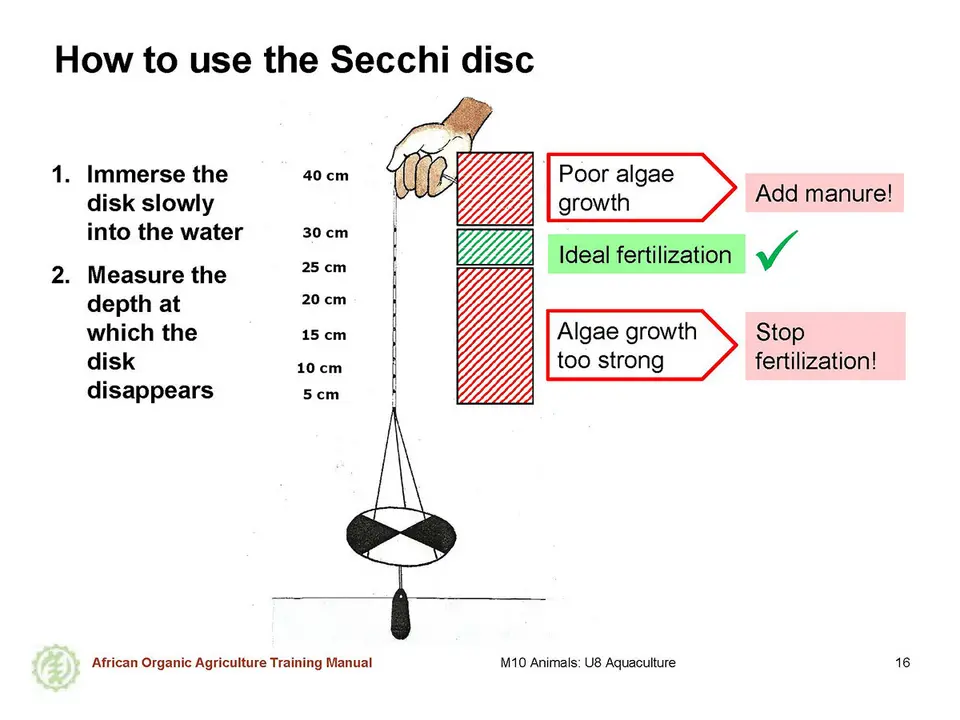
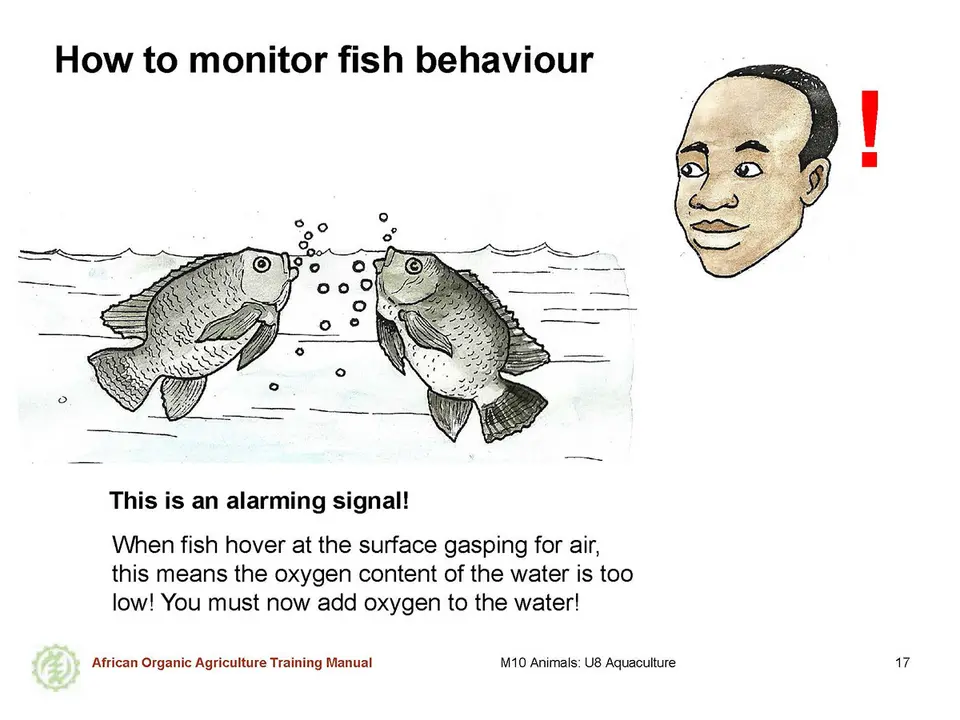
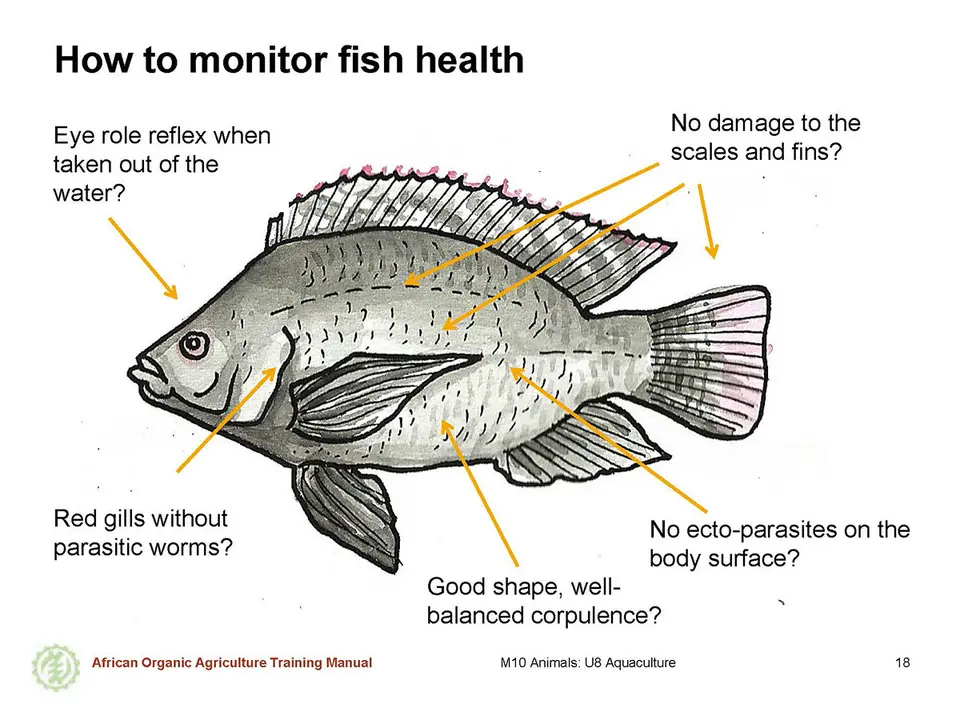
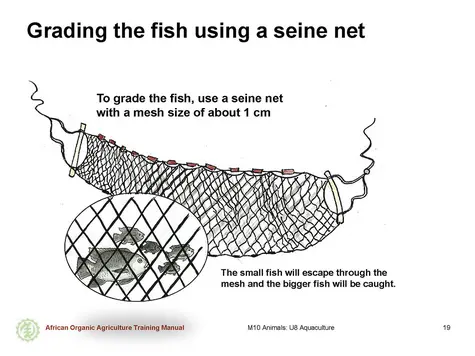
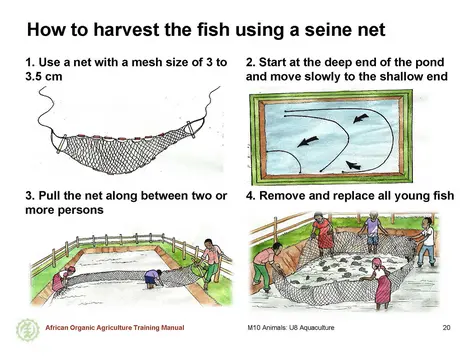
 tap and then scroll down to the Add to Home Screen command.
tap and then scroll down to the Add to Home Screen command.